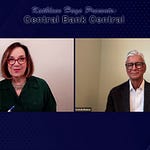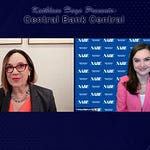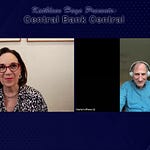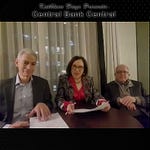Jeffrey Lacker is the former president of the Federal Reserve Bank of Richmond, a longtime member of the Shadow Open Market Committee, and an economist who loves writing about history. No surprise then that he presented a fascinating paper at the SOMC's conference this week in Washington D.C, “How the Fed Can Improve Its Policy Framework.”
Five years ago at the Fed’s last policy framework review the big concern for policy makers was that in the years since the last framework review in 2012, when they finally formally adopted a two percent inflation target, the inflation rate mostly ran just below 2% after that adoption. So when they revised their policy framework in 2020 they said they would need to see inflation rising at or above 2% with employment heading clearly toward what they called - never clearly defined - maximum employment before they would start raising rates.
Ironically this change was put in place just as the pandemic was hitting and the Fed’s new strategy, many argue, was one big reason why inflation surged out of control and needed aggressive rate hikes to bring it back down.
Enter Jeff and his SOMC paper. He traces the evolution of what he sees as a deliberate move by the Fed in 2020 to prioritize maximizing employment over, and ahead of, making sure it achieves keeping inflation steady at 2%. Jeff discusses developments back to the debates around the 2012 Framework Review — and even to the dynamics of publicly announcing its two percent target for the first time - back to 1995 decisions.
So dive in and hear what he has to say. If this doesn’t entice you to read his detailed paper, I don’t know what will. Whether you are a professional Fed-watching economist, a first-year economics student, or someone who follows financial news and is wondering what this 2025 Framework is, you will be glad you did.
Here’s where to find Jeff’s “Maximum Employment and the Federal Reserve’s Monetary Policy Strategy:”
https://shadowfed.org/wp-content/u soploads/2025/04/Lacker-presentation-SOMC-Spring-2025.pdf
The Fed’s mandates & priorities: In the Beginning - 00:01:13:02
The Fed's dual mandate is employment. Keeping it healthy and inflation. And under the current regime for many years, keeping inflation around 2%. That's the target. So I want to start with this employment mandate side. You know it at one time, Paul Volcker, Alan Greenspan, previously famous, you know, Fed chair, would have said, you know, keep that inflation low, keep price stability. And then we got this dual mandate and employment became a very important part of it.
The elevation of the employment goal 00:01:39:21
You see it in 2012, you see it in 2020 and even before. So how did employment come to sort of rise this position of being at least as important as price stability? It's been a long struggle for the Federal Reserve, how to deal with the employment side of its mandate that mandate was delivered by Congress in legislation enacted in 1977, where it listed three goals actually (1) maximum employment, (2) price stability and (3) moderate long term interest rates. Now, the third one is sort of interesting because nobody talks about it and it's for a good reason. Everyone understands that the best contribution monetary policy can make to moderate long-term interest rates is to keep inflation low, because interest rates build in a premium to compensate for expected inflation. And if you keep expected inflation, low, interest rates will be moderate.
Paring back the responsibilities and Fed capabilities 00:02:37:13
And so people have just dropped that. And just think about the two maximum unemployment and price stability. Now, the two are different in important ways. The central bank can control inflation. It can make it to it can make it zero. It can make four or five. The Fed can't do that with employment. The Fed central bank cannot have a sustained effect on real economic activity other than just damaging the economy, throwing it into recession and letting it recover. But the pace of the recovery is generally governed by real factors. The frictions involved, the the costs involved in reallocating workers and capital from sectors that decline and in the last recession and absorbing them into sectors that are expanding in this new recovery.
Long-run-short run distinction… Or not? 00:04:13:23
The debate for a long time <has been> well, it's a short run- Long run, man. I mean, in the short run, the Fed can raise rates and that can have an effect on economic activity in the near term. But over the longer run, that effect fades out. But the effect on inflation can be long lived. And so and this is this isn't just my <personal> view. This is the broad consensus of the economics profession since the 1970s. So that mandate has been interpreted differently by different federal reserves. As you pointed out, Volcker and Greenspan and William McChesney Martin before them in the fifties and sixties, had held the view that the best contribution the Fed can make to employ mid maximum employment is to keep the price level growing at a slow, steady rate.
The Secret inflation man target? 00:05:31:06
Kathleen Asks <you say in our paper that>…the inflation objective was not put in place as a2% target until 2012. In that big framework review and this policy that was set forth, but an undisclosed objective of 2% for 15 years before making it an official target. Is that typical of how the Fed does things and how did that work? Lacker Responds (how it happened): So in 1995, legislation was introduced in Congress that would give the Fed a single mandate for price stability rather than the dual mandate. Greenspan was going to have to testify about it, and he wanted to know the committee's views. So, he sponsored a couple of discussions, the result of which was and without him planning it, the committee spontaneously all agreed that we want to hold the line on inflation at 2%. So keep in mind, of all the seventies, high inflation, eight, ten, 12%, Volcker brings it down to three or four… Greenspan brings it down to two in the mid-nineties, and the Fed says, let's hold the line here. We want to keep inflation at 2%. Internally, the Greenspan says warns the committee not to let it out of the committee room because there'd be a lot of political blowback. And the blowback, of course, would have been because it you know, that that would seem like abandoning that employment side of the mandate…(then there is a> time lag between then and 2012 <when the 2% target was adopted formally, publically>.
Bernanke and the public 2% target 00:06:54:14
So, Bernanke comes in as chair. He's a strong proponent <of inflation targeting>. He's been on record as an academic. Yeah. And yet he's not able to get it over the finish line for seven years. And the problem was grappling with the mandate and developing a consensus on the committee about what the employment mandate meant. So in 2012, the 2% inflation target is made explicit.
Employment mandate has been the fly in the ointment 00:07:41:01
The framework was revised in 2020 and now they're talking about revising it again. So that's what's at stake. That employment paragraph was an uneasy compromise and there was a first three sentences that were written by a bunch of Reserve Bank presidents that was fair and ecumenical.<but it was changed…> And <that change> muddied the whole message by making a reference to the longer run projections for the unemployment rate that were in the summary of economic projections (SEPS), which just recently, just within the last couple of years in 2012 had started being released. It pointed to those numbers. Now, it didn't say that <the SEPS number> corresponds to maximum employment. A bunch of people would have voted against it if it did, but it implied it was equated and it's been confusing ever since.
New framework listed the employment mandate first 00:09:50:17
It was symbolic that they move the employment paragraph to before the inflation paragraph, but that there were a lot of other changes to how the employment mandate side of the mandate was described and handled…
that contributed to the whole framework very clearly elevating the employment mandate and by implication downgrading the inflation target mandate. And that, combined,,,<with> and the way it was implemented had an influence on the inflation surge <reference to pandemic>.
Lacker’s proposal 00:09:50:17
I think that's the key issue in the review this year. And what I'm advocating in this paper <see ling to paper>, what I advocate in this paper, is that they forge ahead, they back away from some of the mistakes they made in the 2020, but they did craft something that's even better than the 2022, a much better than the 2012.<What can they improve?..numbering added> 1) recognize that in maximum employment next quarter is different from maximum employment three years from now. 1a) Make clear that that's different. 2) Make clear the that the Fed can't guarantee that they can get to maximum employment in the long run and that there are limits to what the Fed can do about employment in the short run and…3) it would be good wise to revert to the formulation of Volcker and Greenspan that price stability is the best contribution that can make to maximum employment.
JEFFREY LACKER
I am currently a Senior Affiliated Scholar at the Mercatus Center at George Mason University and a member of the Shadow Open Market Committee. and a Fellow of the Global Interdependence Center College of Central Bankers. I worked at the Federal Reserve Bank of Richmond from 1989 to 2017, where I was President from 2004 to 2017. From 2018 to 2022 I was Distinguished Professor in the Department of Economics at the Virginia Commonwealth University School of Business in Richmond, VA. From 1984 to 1989 I taught at the Krannert School of Management at Purdue University. Early in my career I worked at Wharton Econometric Forecasting Associates.
You can find my academic and Federal Reserve publications from before 2017 at this Richmond Fed web page. Speeches and testimony from that time on central bank policy issues (as opposed to the economic outlook) can be found here under the "At the Fed" tab. Post-2017 work can be found at the tabs for "Recent Appearances" and "Recent Writings". All the speeches I gave as Richmond Fed President are listed at this Richmond Fed web page. This IDEAS/RePEc page lists all my publications.
My biography on the Federal Reserve History web site is here, and the Wikipedia page about me is here. A bio is here.
I am currently associated with the following organizations:
Shadow Open Market Committee, Member
Mercatus Center at George Mason University, Senior Affiliated Scholar
Global Interdependence Center College of Central Bankers, Fellow
Richmond Jewish Foundation, Board of Directors
Council for Economic Education, Board of Directors
Virginia Council on Economic Education, Board of Directors
World Affairs Council of Greater Richmond, Board of Directors
University of Richmond, Trustee Emeritus
Amateur sports car racing has been my hobby; there are some related links here.










